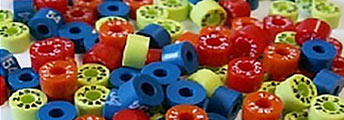What's the Difference Between Upcut and Downcut Flush Trim Bits?
If you've spent any time working with PCBs, you've probably stared at two seemingly identical router bits and wondered if it really matters which one you use. The short answer? Absolutely. The longer answer reveals why your choice of PCB router bits can make or break your next project.
The Basic Difference: It's All About Direction
Upcut and downcut PCB router bits differ primarily in how their flutes are oriented and how they move material:
- Upcut bits have flutes that spiral upward, pulling chips away from your work. This keeps your cutting path clear and prevents material from getting packed down.
- Downcut bits do the opposite — the flutes push everything downward as you cut, applying pressure on your material for different cutting results.
When Upcut Bits Are Your Best Option
Most PCB shops reach for upcut router bits as their go-to option, and for good reason:
- Superior chip clearance: Upcut PCB router bits actively remove material, keeping your spindle parts cooler and extending equipment life.
- Clean bottom edges: When you need sharp bottom edges, upcut drill router bits deliver consistently better results.
- Faster feed rates: They clear chips efficiently, allowing higher feed rates without overheating — crucial when you're on deadline.
The main drawback? Upcut router bits can cause fraying on the top surface of your board — a tradeoff many find acceptable for the speed and efficiency gains.
Why You Might Need Downcut Bits
Downcut PCB router bits solve specific problems that make them essential in certain situations:
- Perfect top edges: Downcut bits create smoother top edges compared to upcut options.
- Layer protection: The downward pressure helps prevent delamination by pressing PCB layers together during cutting.
- Stabilizing thin materials: The downward force holds thin PCBs in place, reducing vibration.
- Reduced burring: For metal-core PCBs, downcut router bits significantly reduce top-side burrs.
The trade-off is that chips get pushed downward, leading to potential recutting and heat buildup. Many fabricators compensate by reducing feed rates, and spindle parts may experience different wear patterns with downcut bits.
Compression Bits: The Best of Both Worlds
Compression PCB router bits combine both cutting actions in one tool — downcut geometry near the top and upcut near the bottom — delivering clean edges on both surfaces.
They're ideal when:
- Both top and bottom edge quality matter
- You're working with materials prone to fraying
- You need presentation-quality edge finishes
While more expensive, compression drill router bits eliminate the need for multiple passes with different tools.
Making the Right Choice for Your Project
When deciding between upcut and downcut flush trim bits:
Choose upcut PCB router bits when:
- You're doing standard through-cutting operations
- Heat management and chip evacuation are priorities
- You're pushing for higher production speeds
- Bottom edge quality takes precedence
Select downcut drill router bits when:
- Top surface appearance is critical
- You're working with thin or delicate materials
- You need to prevent delamination
- You're cutting materials that chip easily
Your spindle setup also affects performance. Well-maintained spindle parts with minimal runout improve results with any bit type. Regular inspection prevents costly failures and ensures consistent cutting quality.
What the Pros Do
Experienced shops keep both types of PCB router bits on hand. A common approach: use upcut bits for roughing and general cuts, then switch to downcut bits for finishing passes where edge quality matters.
For small runs, engineers often prefer upcut drill router bits for versatility, while production setups may use multiple specialized bit types in sequence.
Bottom Line
- Upcut PCB router bits excel at chip evacuation and produce clean bottom edges.
- Downcut PCB router bits deliver superior top edges and keep thin materials stable.
At Midwest Circuit Technology, we stock all varieties of these essential tools. Our diamond-cut PCB router bits are engineered for circuit board fabrication, with optimized geometries for various materials.
Need help selecting the right drill router bits for your application? Our team works with these tools daily. Call us at (330) 995-6900 or visit mctinfo.net. With most spindle parts and router bits in stock, you can get back to creating perfect boards without delay.
